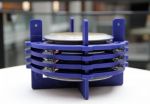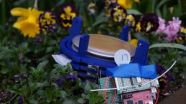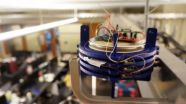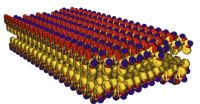(Press-News.org) A centuries-old clock built for a king is the inspiration for a group of computer scientists and electrical engineers who hope to harvest power from the air.
The clock, powered by changes in temperature and atmospheric pressure, was invented in the early 17th century by a Dutch builder. Three centuries later, Swiss engineer Jean Leon Reutter built on that idea and created the Atmos mechanical clock that can run for years without needing to be wound manually.
Now, University of Washington researchers have taken inspiration from the clock's design and created a power harvester that uses natural fluctuations in temperature and pressure as its power source. The device harvests energy in any location where these temperature changes naturally occur, powering sensors that can check for water leaks or structural deficiencies in hard-to-reach places and alerting users by sending out a wireless signal.
"Pressure changes and temperature fluctuations happen around us all the time in the environment, which could provide another source of energy for certain applications," said Shwetak Patel, a UW associate professor of computer science and engineering and of electrical engineering.
The UW team will present its research at the Association for Computing Machinery's International Joint Conference on Pervasive and Ubiquitous Computing this month in Seattle.
The system works like this: A metal bellows about the size of a cantaloupe is filled with a temperature-sensitive gas. When the gas heats and cools in response to the outside air temperature, it expands and contracts, causing the bellows to do the same. Small, cantilever motion harvesters are placed on the bellows and convert this kinetic energy into electrical energy. This powers sensors that also are placed on the bellows, and data collected by the sensors is sent wirelessly to a receiver.
A number of battery-free technologies exist that are powered by solar and ambient radio frequency waves. The researchers say this technology would be useful in places where sun and radio waves can't always penetrate, such as inside walls or bridges and below ground where there might be at least small temperature fluctuations.
For instance, the device could be placed in an attic or inside a wall, and sensors would be tuned to check for water leaks. Similarly, when used inside a bridge, the sensors could detect any cracks forming or structural deficiencies. In both cases, the sensors would send a signal to the nearby powered receiver.
A temperature change of only 0.25 degrees Celsius creates enough energy to power the sensor node to read and send data wirelessly to a receiver 5 meters away. That means any slight shift in an office building's air conditioning or the natural outside air temperature during the course of a day would be more than enough to activate the chemical in the bellows.
The UW's technology uses temperature changes over time as its power source. Devices called thermoelectric generators also leverage varying temperatures for power, but these instruments require a temperature difference at an exact moment, such as in a place where one side is hot and the other is cool.
The researchers have filed patents for the technology and plan to make it smaller, about the size of a D battery. A future version would include four chemicals that activate in different temperature ranges so the same device could be used in various climates.
"I think our approach is unique," said Chen Zhao, lead author and a UW doctoral student in electrical engineering. "We provide a simple design that includes some 3-D printed and off-the-shelf components. With our Web page and source code, others can download and build their own power harvesters."
INFORMATION:
Other members of the research team are Joshua Smith, a UW associate professor of computer science and engineering and of electrical engineering; Sam Yisrael, an undergraduate student in electrical engineering; Sidhant Gupta, a former UW doctoral student; and Eric Larson, an assistant professor at Southern Methodist University and former UW doctoral student.
This research was funded by the Intel Science and Technology Center for Pervasive Computing at the UW and the Sloan Foundation.
For more information, contact the research team at temperature-harvester@uw.edu.
Project website: http://ubicomplab.cs.washington.edu/projects/TemperaturePowerHarvester
Related paper: http://homes.cs.washington.edu/~chzhao/papers/PowerSensorwithAmbientTemperatureChanges.pdf
Posted with photos, video: http://www.washington.edu/news/2014/09/03/changing-temperature-powers-sensors-in-hard-to-reach-places/
Changing temperature powers sensors in hard-to-reach places
2014-09-03
ELSE PRESS RELEASES FROM THIS DATE:
Tweets during 2013 Colorado floods gave engineers valuable data on infrastructure damage
2014-09-03
Tweets sent during last year's massive flooding on Colorado's Front Range were able to detail the scope of damage to the area's infrastructure, according to a study by the University of Colorado Boulder.
The findings can help geotechnical and structural engineers more effectively direct their reconnaissance efforts after future natural disasters—including earthquakes, tsunamis and tornadoes—as well as provide them data that might otherwise be lost due to rapid cleanup efforts.
"Because the flooding was widespread, it impacted many canyons and closed off access to communities ...
Galapagos invasion is global warning
2014-09-03
A new study led by a PhD researcher at The University of Western Australia has revealed that parts of the iconic Galapagos Islands have been overrun by invasive plants from other parts of the world.
"People may be shocked that a place considered so iconic for biodiversity is so overrun with weeds in some areas despite ongoing control effort by National Park rangers, but this is really a global story," lead author from the UWA School of Plant Biology Mandy Trueman said.
The results published in the open access journal Neobiota confirm that in the humid highland part ...
Peptoid nanosheets at the oil-water interface
2014-09-03
From the people who brought us peptoid nanosheets that form at the interface between air and water, now come peptoid nanosheets that form at the interface between oil and water. Scientists at the U.S. Department of Energy (DOE)'s Lawrence Berkeley National Laboratory (Berkeley Lab) have developed peptoid nanosheets - two-dimensional biomimetic materials with customizable properties - that self-assemble at an oil-water interface. This new development opens the door to designing peptoid nanosheets of increasing structural complexity and chemical functionality for a broad ...
How well does bariatric surgery work?
2014-09-03
SEATTLE—The number of bariatric surgeries done each year in the United States has ballooned. Now, in an August 27 state-of-the-art review in The BMJ and a September 3 editorial in JAMA, David Arterburn, MD, MPH, weighs the evidence on the benefits and risks of the various types of this surgery.
"It's critical that we find effective—and cost-effective—ways to treat severe obesity," said Dr. Arterburn, an associate investigator at Group Health Research Institute, a Group Health physician, and an affiliate associate professor of medicine at the University of Washington School ...
Are human breast milk microbiomes 'neutral'?
2014-09-03
Human breast milk is considered the most ideal source of nutrition for infants and it should have played a critical role in the evolution and civilizations of human beings. Unlike our intuitive perception, human milk contains a large number of bacterial species, including some opportunistic pathogens of humans. This phenomenon comes as no surprise to scientists and physicians.
Indeed, the existence of milk microbiome is considered to be the result of co-evolutionary and co-adaptive interactions between the microbiome and human host. Furthermore, the dynamic balance in ...
The Lancet Respiratory Medicine: Household air pollution puts more than 1 in 3 people worldwide at risk of ill health and early death
2014-09-03
Household air pollution, caused by the use of plant-based or coal fuel for cooking, heating, and lighting, is putting nearly three billion people worldwide at risk of ill health and early death, according to a new Commission, published in The Lancet Respiratory Medicine journal.
A third of the world's population use plant-based solid fuels such as wood or charcoal, or coal, to cook, heat, and light their homes, primarily in Asia and Africa. These smoky, dirty fuels are often used in an open fire or simple stove, resulting in high levels of household air pollution in poorly ...
Researchers reveal carbon emissions of PlayStation 3 game distribution
2014-09-03
It's not always true that digital distribution of media will have lower carbon emissions than distribution by physical means, at least when file sizes are large.
That's the conclusion of a study published in Yale's Journal of Industrial Ecology that looked at the carbon footprint of games for consoles such as PlayStation®3. Researchers found that Blu-ray Discs delivered via retail stores caused lower greenhouse gas emissions than game files downloaded over broadband Internet. For their analysis, the investigators estimated total carbon equivalent emissions for an 8.8-gigabyte ...
'Prepped' by tumor cells, lymphatic cells encourage breast cancer cells to spread
2014-09-03
Breast cancer cells can lay the groundwork for their own spread throughout the body by coaxing cells within lymphatic vessels to send out tumor-welcoming signals, according to a new report by Johns Hopkins scientists.
Writing in the Sept. 2 issue of Nature Communications, the researchers describe animal and cell-culture experiments that show increased levels of so-called signaling molecules released by breast cancer cells. These molecules cause lymphatic endothelial cells (LECs) in the lungs and lymph nodes to produce proteins called CCL5 and VEGF. CCL5 attracts tumor ...
Exposure of pregnant women to certain phenols may disrupt the growth of boys
2014-09-03
A research consortium bringing together teams from Inserm, the Nancy and Poitiers University Hospitals, and the Centers for Disease Control and Prevention (CDC, Atlanta, USA), and coordinated by the Inserm and University of Grenoble Environmental Epidemiology team (Unit 823), has just published an epidemiological study indicating that exposure to certain phenols during pregnancy, especially parabens and triclosan, may disrupt growth of boys during foetal growth and the first years of life. Bisphenol A was not associated with any definite modification in growth. These results ...
Survey: Number of Texans without health insurance drops under Affordable Care Act
2014-09-03
HOUSTON – (Sept. 3, 2014) – The percentage of Texans without health insurance dropped after the first enrollment period of the Affordable Care Act (ACA), according to a report released today by the Episcopal Health Foundation and Rice University's Baker Institute for Public Policy.
The report found that since the opening of the ACA's Health Insurance Marketplace, the percentage of uninsured adult Texans dropped by a little more than 2 percent. The report estimates 378,000 more Texans had health insurance in June 2014 than in September 2013.
The small gain in Texans ...





